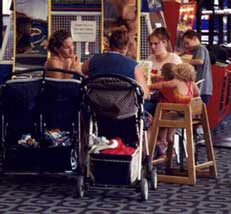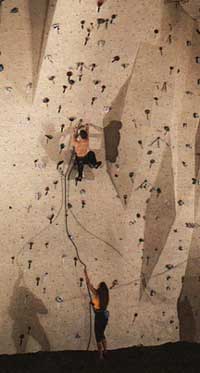
Vol. II, No. 9, November 2002
THE HOMEMAKER MARKET
Probably the most overlooked market for community-based entertainment venues is the homemaker market. Homemakers are defined as non-working parents (mostly women, but men do make up 18% of the market). The majority of homemakers have children. For purposes of this article, homemakers will refer to non-working parents with children.
One reason the homemaker market is typically ignored is that in the majority of families, both parents work, so the size of this niche market is assumed to be insignificant. True in part; in 2001, 63% of families with children had both parents employed. However, for the remaining 37% of families, at least one-parent did not work. That can add up to a lot of families.
 When
we dig into the statistics, things start to get interesting, especially for
families with younger children. When we look at families that have preschooler
children (younger than 6 years), the percentage of homemaker families grows
to 42%. That can add up to a lot of potential attendance during what would
otherwise be weekday down time.
When
we dig into the statistics, things start to get interesting, especially for
families with younger children. When we look at families that have preschooler
children (younger than 6 years), the percentage of homemaker families grows
to 42%. That can add up to a lot of potential attendance during what would
otherwise be weekday down time.
When we dissect the data even further based on the age of the preschoolers, we find that the families with the youngest children have the highest percentage of homemakers. The homemaker percent is 49% for families with children younger than one.
Even for single-parent households, there are some homemakers. In women-headed households with preschoolers, 32% of the mothers did not work in 2001, and in men-headed households with preschoolers, 14% of the fathers did not work. Although many of these single-parent households belong to the lower-socioeconomic segments of society, there are still some with substantial incomes, including many divorced parents living on alimony and child support.
Other demographic variables that affect the presence of homemakers include age, income, education and region of the country.
Current data also indicates the possibility of a reversal of a decades old trend. The percentage of homemakers has been continually decreasing since the 1950's, as more and more families became dual-income. In 1950, only 12% of married mothers with preschoolers worked. The percentage has steadily increased to 30% in 1970, 45% in 1980 to a high of 59.9% in 2000. Then in 2001, the percentage deceased 1/2 percent to 59.4%, the first such decrease in over 50 years. The percentage of homemakers with 6-year and older children also decreased by a full percent in 2001. Those decreases would not reflect the stronger focus on family values triggered by 9/11, so we may well be seeing the beginning of a longer-term trend of more parents valuing caring for their children over earning additional income.
The above homemaker data does not include part-time, shift or flex-time workers or self-employed workers who work at home, all who spend some time during the weekday daytime hours at home with their children.
Why is the homemaker so important? It's rather fundamental. These parents are looking for places during the day where they can meet their friends to socialize while their children are entertained. They can generate significant business during the daytime hours when schools are in session, a time with most family oriented facilities are empty. Given the right facilities and amenities, they will visit every week, or even more often. Chuck E. Cheese's learned years ago how important this market is. Over 20% of Chuck E. Cheese's customers visit more than 20 times a year. Yes, that's right, 1/5 are high frequency customers. This data is from independent research, not from CEC. Visit any CEC mid-day and you will find groups of mothers with preschoolers sitting and socializing while their children play. Many meet there every week.
When our company designs family entertainment facilities for our clients, we give special attention to this important niche market. We first examine, in detail, the size and characteristics of the homemaker market during our market feasibility work. Then, if this niche market is sizable enough to merit targeting, we incorporate the features, amenities and programs in the design of the facility required to attract homemakers on a regular basis. We even include age appropriate entertainment/play features for infants and toddlers, the age group of children with the largest percentage of homemakers who are usually most desperate to find places that meet their needs.
Children's edutainment centers are ideal for capturing this market, as they
are targeted to the age range of children that includes preschoolers. Learn
about children's edutainment centers in next month's issue.


 ROCK CLIMBING GROWS IN POPULARITY
ROCK CLIMBING GROWS IN POPULARITY